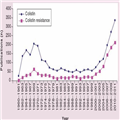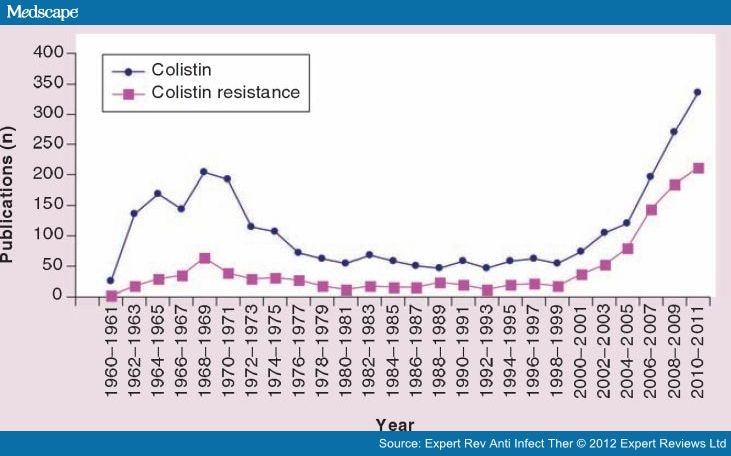Abstract and Introduction
Abstract
The emergence of multidrug-resistant Gram-negative bacteria that cause nosocomial infections is a growing problem worldwide. Colistin was first introduced in 1952 and was used until the early 1980s for the treatment of infections caused by Gram-negative bacilli. In vitro, colistin has demonstrated excellent activity against various Gram-negative rod-shaped bacteria, including multidrug-resistant Pseudomonas aeruginosa, Acinetobacter baumannii and Klebsiella pneumoniae. Recent clinical findings regarding colistin activity, pharmacokinetic properties, clinical uses, emerging resistance, toxicities and combination therapy have been reviewed. Recent approaches to the use of colistin in combination with other antibiotics hold promise for increased antibacterial efficacy. It is probable that colistin will be the 'last-line' therapeutic drug against multidrug-resistant Gram-negative pathogens in the 21st century.
Introduction
The emergence of multidrug-resistant (MDR) Gram-negative bacteria in parallel with the lack of new antibacterial agents led scientists to understand the importance of polymyxins.[1,2] There has recently been a tremendous increase in infections caused by MDR Gram-negative bacteria, especially Pseudomonas aeruginosa, Acinetobacter baumannii and Klebsiella pneumoniae, and for these species, polymyxins are often the only available active antibiotics.[1,3–9] Polymyxins consist of polymyxins A–E, of which polymyxinB (PMB) and polymyxin E, or colistin, are currently available in the market. When the use of β-lactam, aminoglycoside or quinolone is ineffective, the polymyxins, especially colistin, serve as the final alternative treatment.[4,10] Despite of a daily selective pressure in patients receiving colistin by inhalation, resistance to colistin is seldom observed.[11,12] In 2000, Littlewood et al. in their review described the use of colistin by inhalation in a Danish cystic fibrosis (CF) center for daily maintenance therapy in 120 CF patients with chronic P. aeruginosa lung infection since 1987. During this study, colistin-resistant strains were only observed in 14patients (MIC: 100–400 µg/ml).[12]
Colistin became available for clinical use in the 1960s, but was replaced in the 1970s with other antibiotics owing to its toxicity.[1,4,13] There are two forms of colistin available in the market: colistin sulfate (tablets or syrup for oral use and powder for topical use), which is also available as an aqueous suspension solution for topical use in eyes and ears (e.g., Coly-Mycin®S Otic), and colistin methanesulfonate (colistimethate sodium [CMS]) for parenteral use.[2,14] Both of these forms can also be delivered by inhalation.[3] Colistin methanesulfonate, or CMS, was largely replaced with aminoglycosides in the 1970s because of concern about its neurotoxicity and nephrotoxicity.[1,4,10,15]
Figure 1 represents the number of citations found in the PubMed database from 1960 to the middle of 2011 using either the search phrase 'colistin' or 'colistin resistance'. This graph shows the trend in colistin use, which has increased from the early 21st century, with a higher number of publications on colistin, and it also shows the problem with colistin resistance, with an increasing number of publications on this topic.
Figure 1.
Number of citations found in the PubMed database from 1960 to the middle of 2011 using either the term 'colistin' or 'colistin resistance'.
In recent years, colistin has attracted considerable interest as an antibiotic for use against MDR strains. The aim of this review is principally to discuss the antibacterial activity of colistin, mechanisms of action and resistance, combination therapy and also its use for the treatment of infections due to MDR Gram-negative infections in patients with or without CF. Pharmacokinetic (PK) properties of colistin will be discussed in a short section, as they are beyond the scope of this review. The review provide updated information to enable clinicians to choose this drug for proper use as a treatment option against pathogenic bacteria.
Expert Rev Anti Infect Ther. 2012;10(8):917-934. © 2012 Expert Reviews Ltd.







